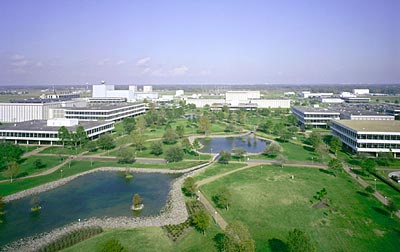Leadership at Johnson Space Centerby Anthony Young
|
| “There were many heroes during the early days of the space program, but Bob Gilruth was the most respected of them all and, particularly, by those who knew what it took to reach the goals that were established,” said Kraft. |
Chris Kraft had almost as much impact on NASA as Gilruth himself. He was flight director during Mercury and Gemini and directed the design and implementation of Mission Control in Houston. He served under Gilruth as deputy director of the MSC, and became its director upon Gilruth’s retirement. With his many years of experience in aeronautics, astronautics, and manned spaceflight, Kraft was a superb successor to Gilruth at the MSC during Apollo, Skylab, and the start of the space shuttle era. His autobiography Flight: My Life in Mission Control records his eventful life and preserves the dawn of America’s manned spaceflight for current and future generations.
Since Kraft retired as director of the Johnson Space Center over 20 years ago, there have been six individuals running the center, apart from Coats. Few of them had the depth or breadth of experience displayed by Gilruth and Kraft, and the tenure of some of them was shockingly brief.
Gerald D. Griffin served as Lead Flight Director for Apollo 12, 15, and 17, and would have done so on Apollo 13 when fate intervened. He worked his way up through the NASA hierarchy until be became director of the Johnson Space Center in 1982, but served less than four years.
Jesse W. Moore became director of the center in January 1986; five days after taking the position the shuttle Challenger disintegrated during launch. He holds the dubious distinction of being center director for a mere ten months. I could find nothing about him in the search engines or even NASA’s own website, except for a brief mention on the Johnson Space Center website. He is a mystery man. Why was such a man appointed director of one of NASA’s most important centers?
In October 1986, Aaron Cohen became JSC’s fifth director. He was a NASA veteran, first working at the Manned Spacecraft Center in 1962 and was involved in Gemini and Apollo. He later directed the development and testing of the space shuttle orbiter. He served as center director until August 1993, later becoming a professor of engineering at Texas A&M.
Cohen was followed by Carolyn L. Huntoon. She joined the MSC in 1970 as a life sciences researcher. What she did in Houston for 23 years was something I could not find out, except for some references to the Shuttle-Mir program. She served less than two years as JSC director before moving on to serve other roles in the US government, most notably as Assistant Secretary of Environmental Management for the Department of Energy. I’m serious. Then it became clear. She was a bureaucrat.
| Many wonder what Coats will do to guide and direct JSC as it enters the Vision for Space Exploration era, while simultaneously handling both the shuttle and ISS programs. It is a very tall order, and one can only hope that Coats can follow in the footsteps of Robert Gilruth and Christopher Kraft. |
Huntoon was followed by George Abbey in January 1996. Abbey was also another NASA veteran going back to Apollo. In the shuttle program, he was Director of Flight Operations and Director of Flight Crew Operations. He held other positions within NASA before being appointed Director of JSC. The biggest piece of the pie Abbey was responsible for was JSC’s involvement with the International Space Station. He could not put a brake on the ISS’s cost overruns, for which NASA took the most heat. He was removed as director in February 2001 and was re-assigned as Senior Assistant for International Issues at NASA Headquarters.
Roy S. Estess, another NASA long-timer, became Acting Director of JSC. He had been Director of Stennis Space Center since 1989. Stennis has been at the center of America’s rocket engine development since the 1960s, and Estess was there. He was a good choice as Acting Director, which he remained until March 2002.
That was when NASA brought in retired Marine Gen. Jefferson D. Howell to try to get a grip on the agency’s costly human spaceflight programs and try to reform JSC’s management structure. Howell came from Science Application International Corporation (SAIC), an aerospace research and engineering company headquartered in California. At SAIC, Howell managed the company’s shuttle safety and space station contracts. Howell might have kept his job for quite a bit longer, but NASA’s new administrator, Dr. Michael Griffin has been aggressively restructuring NASA upper management to his liking.
Griffin’s choice as JSC’s ninth director is Michael Coats. Coats joined NASA in 1978 as part of the first class of shuttle pilots. He flew on the maiden flight of Discovery in 1984 and commanded two subsequent shuttle missions. He retired from NASA in 1991 and joined Lockheed Martin Astronautics in Denver, Colorado, eventually becoming vice president there. Coats has answered the call from Dr. Griffin, and many wonder what the former shuttle astronaut will do to guide and direct JSC as it enters the Vision for Space Exploration era, while simultaneously handling both the shuttle and ISS programs. It is a very tall order, and one can only hope that Coats can follow in the footsteps of Robert Gilruth and Christopher Kraft. The next five to ten years will be crucial ones for NASA’s human spaceflight program. The first person Coats should sit down with is Christopher C. Kraft himself and pick his brains. I think Kraft would have a few words of wisdom to impart to JSC’s latest director.
